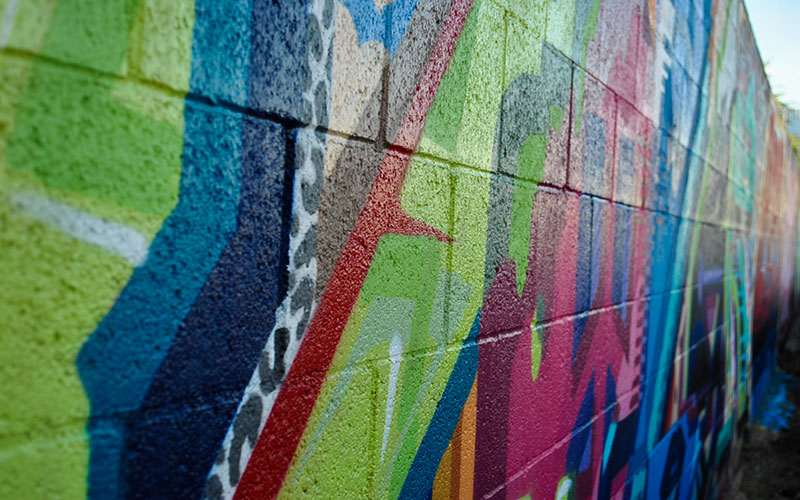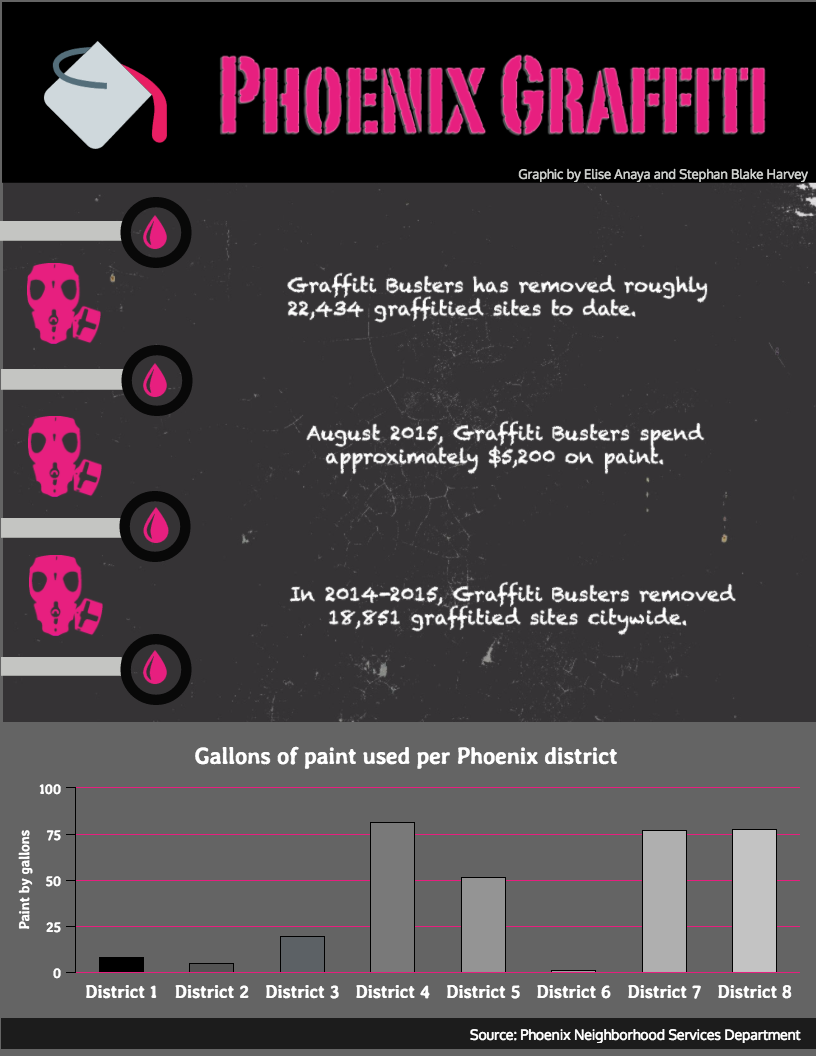- Slug: BC-CNS-Street Art,590
- Infographic available
- Photos available (thumbnails, captions below)
By ELISE ANAYA
Cronkite News
PHOENIX – One of Phoenix’s most prominent art venues is Roosevelt Row. Located on Roosevelt Street between Central Avenue and Seventh Street, it hosts a variety of art fixtures such as Meejin Yoon’s “Shadow Play,” an art installation that was finished in July.
Named a “Great Place in America” by the American Planning Association, downtown Phoenix hosts a variety of entertainment venues, such as opera houses and theaters, but what sets downtown Phoenix aside from other cities are its bold art fixtures.
And the most prominent feature of Roosevelt Row is its street art, the colorful walls line the street.
Some boast the name of a business, such as the wall at Angels Trumpet that is decorated with an orange-winged angel holding a tray of beverages on a yellow background. Others are more abstract, like the black-and-white piece of a man wearing a helmet riding a bike with flowers sprouting from the back of it.
Local street artist Jesse Perry, known as MrDowntownPHX on social media, has several pieces on display in the area. One of his larger works, a wall mural, adorns the northeast wall of the now-closed PAZ Cantina. It features a white rabbit lounging on a bed of cacti while holding a taco in its left hand and a sign reading “Welcome to Downtown” in its right. The future of the mural is uncertain because of the building’s impending demolition.
“Street art is something that really adds either value to a property or cultural value to an area, and that’s something that you will find intrinsic of most street art whether it is commissioned or noncommissioned,” Perry said.
However, there is a difference between street art and graffiti.
“Graffiti really lends itself to the destruction of a property or lowering the property values, something that somebody is going to have to spend money to cover up,” Perry said. “That in the general eye of the public, it’s distasteful.”
Perry added that Phoenix doesn’t have the same amount of regulation on art as other cities. He said that this is because artists would just paint the walls in Phoenix, which helped the city refocus its attention downtown.
“One of the great things that you’re seeing is these artists that put their time and efforts in for free 10 years ago, starting to get paid for it. They’re creating careers and creating inspirational pieces of work that are driving tourists here,” Perry said.
But street art is not always preserved on its urban canvas. Graffiti Busters, an organization that removes graffiti in the greater Phoenix area, cleans up any graffiti, whether it is intended as an art piece or not, on any surface maintained by the city, such as utility boxes, sidewalks and telephone poles.
Sevag Hayan, a Graffiti Busters clerk, said the program only deals with cleaning up graffiti from public areas.
While graffiti may typically be thought of as spray-painted text, the program defines graffiti as anything painted on a fixture that the property owner does not want on their property. But if the property owner says the art is supposed to be there, the program leaves it alone.
“Our goal is to help the property owners,” Hayan said.
Graffiti Busters is a nonprofit organization that reaches out to the community to help clean up neighborhoods. Hayan said that the program works through school groups that want to participate in the cleanup process, and the group’s main goal is to assist the residents of areas that have unwanted graffiti.
“It keeps our crews pretty busy,” Hayan said.
^__=
Jesse Perry’s mural located on an outside wall of PAZ Cantina in downtown Phoenix. (Photo by Stephan Blake Harvey/Cronkite News)
This plant-like bug mural is located on the Western wall of Monochrid which is a venue, gallery and art studio. (Photo by Stephan Blake Harvey/Cronkite News)
This piece of art is located on a wall just east of 2nd street next to the Monochrid building. (Photo by Stephan Blake Harvey/Cronkite News)
This image of a man playing an instrument adorns a wall in downtown Phoenix. (Photo by Stephan Blake Harvey/Cronkite News)
A colorfully painted woman spans one of the walls near 2nd street. (Photo by Stephan Blake Harvey/Cronkite News)
Jesse Perry added that Phoenix doesn’t have the same amount of regulation on art as in other cities. (Photo by Stephan Blake Harvey / Cronkite News)
Jesse Perry says that graffiti is seen as destructive and lowers property values. (Photo by Stephan Blake Harvey / Cronkite News)
Jesse Perry mentioned that artists are paving a career path using their inspirational works of art. (Photo by Stephan Blake Harvey/Cronkite News)
An official with the nonprofit group Graffiti Busters said cleaning up graffiti – which it defines as unwanted painting or other permanent fixtures in public spaces – in Phoenix-area neighborhoods “keeps our crews pretty busy.” (Cronkite News graphic)








